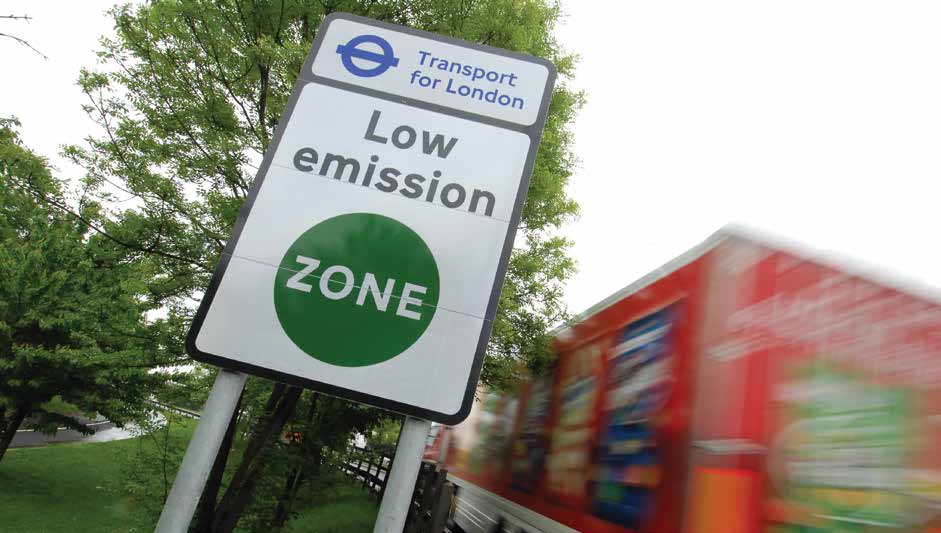
As part of his clean air action plan London’s Mayor Sadiq Khan is introducing a new Ultra- Low Emission Zone in the nation’s capital. Brian Weatherley looks at what it means for truck operators…and Londoners
Assuming there have been no last-minute changes to the original deadline, in less than two years’ time on 8 April 2019 London’s Mayor Sadiq Khan will finally see the introduction of the much-heralded Ultra Low Emission Zone (ULEZ) which lies at the heart of his action plan to improve London’s air-quality.
That’s only the beginning. Before the end of this year there will be a further public consultation on plans to extend the ULEZ beyond its current central London boundaries. However, right now it’s important to understand what the ULEZ is all about, and why it’s arriving 17 months earlier than originally planned.
First of all, the ULEZ will initially cover the same geographic area as the current central London Congestion Charging Zone. Like the existing Low Emission Zone (LEZ), which has a far wider boundary, it will apply 24-hours a day, 365 days a year.
Under the new ULEZ rules, all trucks above 3.5-tonnes must have a minimum engine emissions standard of Euro-6 on NOx and particulates (PMs) matter in order to enter the zone free-of-charge. Otherwise, their registered owners or operators will have to pay a daily charge of £100.
ANPR cameras will read the number plates of vehicles as they enter the ULEZ and their engine emissions rating will be checked against Transport for London’s central database. For the record, the minimum emission standard for the LEZ is Euro-4 on particulates.
If, by 8 April 2019, your vehicle does not meet the ULEZ emissions standards and you fail to pay the daily charge, a Penalty Charge Notice (PCN) will be issued payable by the registered owner or operator. For HGVs this will be £1,000, reduced to £500 if paid within 14 days. For vans it will be £130, reduced to £65 if paid within 14-days. However, it’s important to note that any ULEZ charge levied will be in addition to the congestion charge.
In simple terms, what the ULEZ does is to tighten up the emissions requirement for HGVs operating within central London. But there’s more to come. A statutory consultation on proposals to expand the ULEZ boundary beyond central London will be held before the end of the year.
The Mayor wants to extend the area covered by the ULEZ so that it applies to nearly all of Greater London
The Mayor wants to extend the area covered by the ULEZ so that it applies to nearly all of Greater London. Subject to consultation, this expanded zone, which will have exactly the same boundaries as the LEZ, is planned to come into force in 2020.
It’s not just HGVs that are in the Mayor’s sights. He also wants to extend the ULEZ area for light vehicles – cars, vans, minibuses and motorcycles – up to the North/South Circular roads. Subject to consultation this would be implemented in 2021.
But what’s behind this emphasis on commercial vehicle emissions?
It’s no secret that road transport is a significant source of oxides of nitrogen (NOx) including harmful nitrogen dioxide (NO2). At high concentrations NO2 causes inflammation of the airways, while longterm exposure is associated with an increase in symptoms of bronchitis in asthmatic children and reduced lung development and function.
Currently some 50% of all NOx emissions in Greater London come from road transport. More importantly, from the perspective of commercial vehicle operators, 46% of those road transport NOx emissions are generated by a combination of buses (20%) coaches (6%) HGV rigids (15%) and articulated HGVs (5%).
The other nasty product from diesel exhausts is soot or particulate matter (PM). Long-term exposure to PM contributes to the risk of developing cardiovascular and respiratory diseases, including lung cancer.
Research shows that soot particles with a diameter of 10 microns and smaller (PM10s) – which are not visible to the eye – are likely to be inhaled deep into the respiratory tract. However, the health impacts of particles with a diameter of 2.5 microns or less (PM2.5s) are even greater, as these smaller particles produced by diesel engines can penetrate even further into the lungs.
So an earlier introduction of the ULEZ offers the chance to reduce levels of both NOx and PMs quicker, with the obvious benefits to Londoners. Indeed TfL says that “as a result of implementing the ULEZ in central London sooner, road transport NOx emissions are expected to reduce by an additional 20% in 2019. This is in addition to the reduction expected in 2019 as a result of people adopting cleaner vehicles ahead of the original planned ULEZ start date of September 2020.”
And it goes on to state: “The area of central London exceeding legal limit values for NO2 would reduce from 30% to 22% – and 42% fewer people in central London would be living in areas exceeding the legal limits for NO2 concentrations. There will also be ‘knock-on’ benefits outside central London as a result of cleaner vehicles passing through inner and outer London to access central London.”
Ultimately, while the start date for the ULEZ has come forward a year, the original minimum standard required for HGVs in order to comply with it has remained the same – i.e. trucks must have an engine that meets the Euro-6 standard on NOx and PMs. And as all the major chassis manufacturer have long had Euro-6 models in their line-up there will be no availability issues for those operators who need to buy those cleaner, greener trucks.
Finally, for all those operators who don’t operate within London it’s worth bearing in mind that air quality is rapidly climbing up the agenda in many other major UK cities, not least Manchester and Birmingham, with both cities having expressed an intention to tackle urban air-quality.
Likewise, Leeds, Birmingham, Nottingham Derby and Southampton.




